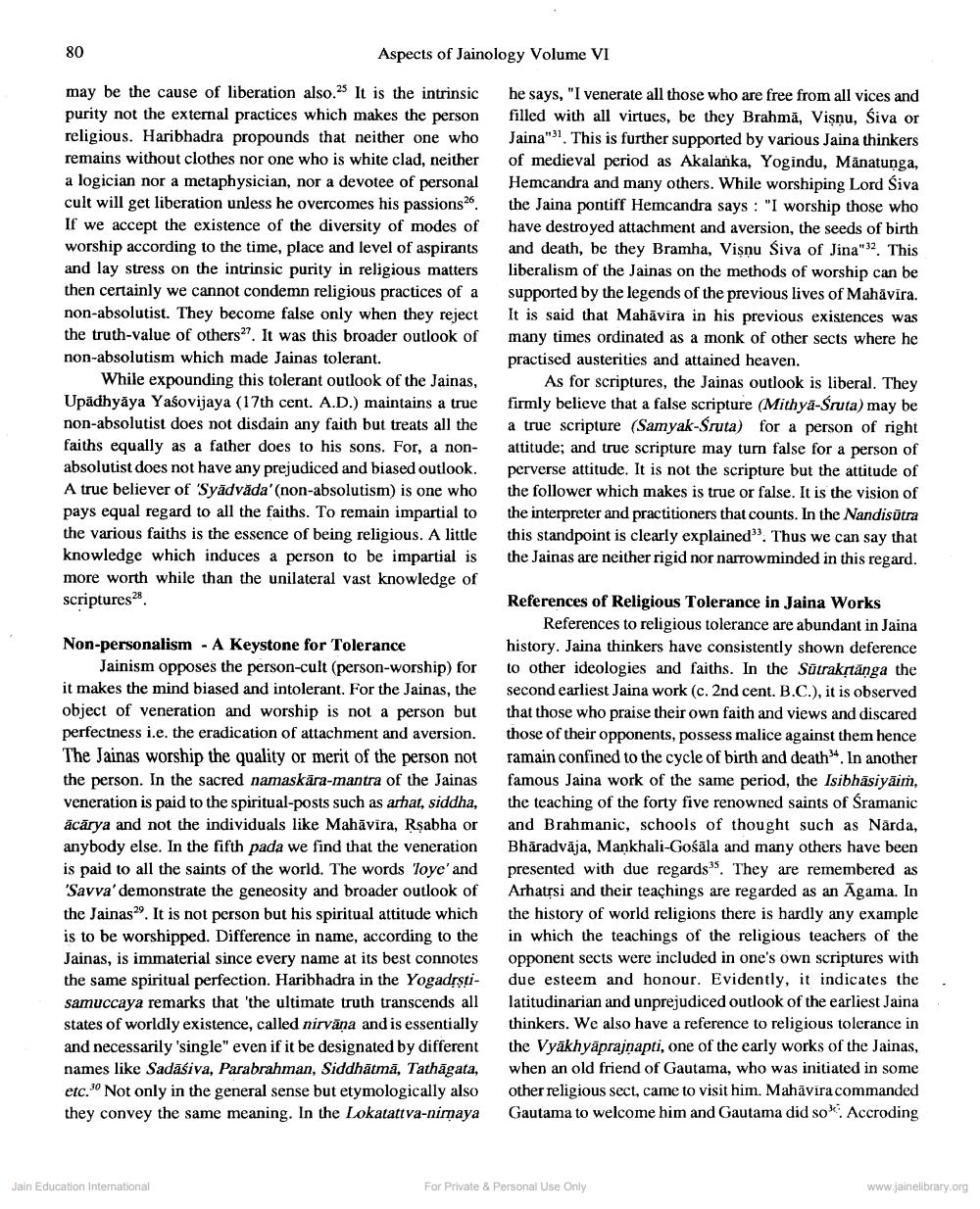________________
80
Aspects of Jainology Volume VI
may be the cause of liberation also.25 It is the intrinsic purity not the external practices which makes the person religious. Haribhadra propounds that neither one who remains without clothes nor one who is white clad, neither a logician nor a metaphysician, nor a devotee of personal cult will get liberation unless he overcomes his passions26 If we accept the existence of the diversity of modes of worship according to the time, place and level of aspirants and lay stress on the intrinsic purity in religious matters then certainly we cannot condemn religious practices of a non-absolutist. They become false only when they reject the truth-value of others27. It was this broader outlook of non-absolutism which made Jainas tolerant.
While expounding this tolerant outlook of the Jainas, Upadhyaya Yasovijaya (17th cent. A.D.) maintains a true non-absolutist does not disdain any faith but treats all the faiths equally as a father does to his sons. For, a nonabsolutist does not have any prejudiced and biased outlook. A true believer of 'Syadvada' (non-absolutism) is one who pays equal regard to all the faiths. To remain impartial to the various faiths is the essence of being religious. A little knowledge which induces a person to be impartial is more worth while than the unilateral vast knowledge of scriptures"
Non-personalism - A Keystone for Tolerance
Jainism opposes the person-cult (person-worship) for it makes the mind biased and intolerant. For the Jainas, the object of veneration and worship is not a person but perfectness i.e. the eradication of attachment and aversion. The Jainas worship the quality or merit of the person not the person. In the sacred namaskara-mantra of the Jainas veneration is paid to the spiritual-posts such as arhat, siddha, ācārya and not the individuals like Mahavira, Rṣabha or anybody else. In the fifth pada we find that the veneration is paid to all the saints of the world. The words 'loye' and 'Savva' demonstrate the geneosity and broader outlook of the Jainas29. It is not person but his spiritual attitude which is to be worshipped. Difference in name, according to the Jainas, is immaterial since every name at its best connotes the same spiritual perfection. Haribhadra in the Yogadrștisamuccaya remarks that 'the ultimate truth transcends all states of worldly existence, called nirvana and is essentially and necessarily 'single" even if it be designated by different names like Sadasiva, Parabrahman, Siddhātmā, Tathāgata, etc.30 Not only in the general sense but etymologically also they convey the same meaning. In the Lokatattva-nimaya
Jain Education International
he says, "I venerate all those who are free from all vices and filled with all virtues, be they Brahma, Viṣṇu, Śiva or Jaina". This is further supported by various Jaina thinkers of medieval period as Akalanka, Yogindu, Mänatunga, Hemcandra and many others. While worshiping Lord Siva the Jaina pontiff Hemcandra says: "I worship those who have destroyed attachment and aversion, the seeds of birth and death, be they Bramha, Visnu Śiva of Jina"32. This liberalism of the Jainas on the methods of worship can be supported by the legends of the previous lives of Mahavira. It is said that Mahavira in his previous existences was many times ordinated as a monk of other sects where he practised austerities and attained heaven.
As for scriptures, the Jainas outlook is liberal. They firmly believe that a false scripture (Mithya-Śruta) may be a true scripture (Samyak-Śruta) for a person of right attitude; and true scripture may turn false for a person of perverse attitude. It is not the scripture but the attitude of the follower which makes is true or false. It is the vision of the interpreter and practitioners that counts. In the Nandisutra this standpoint is clearly explained". Thus we can say that the Jainas are neither rigid nor narrowminded in this regard.
References of Religious Tolerance in Jaina Works
References to religious tolerance are abundant in Jaina history. Jaina thinkers have consistently shown deference to other ideologies and faiths. In the Sutrakṛtänga the second earliest Jaina work (c. 2nd cent. B.C.), it is observed that those who praise their own faith and views and discared those of their opponents, possess malice against them hence ramain confined to the cycle of birth and death34. In another famous Jaina work of the same period, the Isibhāsiyaim, the teaching of the forty five renowned saints of Śramanic and Brahmanic, schools of thought such as Narda, Bharadvaja, Mankhali-Gośāla and many others have been presented with due regards35. They are remembered as Arhatṛsi and their teachings are regarded as an Agama. In the history of world religions there is hardly any example in which the teachings of the religious teachers of the opponent sects were included in one's own scriptures with due esteem and honour. Evidently, it indicates the latitudinarian and unprejudiced outlook of the earliest Jaina thinkers. We also have a reference to religious tolerance in the Vyakhyāprajnapti, one of the early works of the Jainas, when an old friend of Gautama, who was initiated in some other religious sect, came to visit him. Mahavira commanded Gautama to welcome him and Gautama did so. Accroding
For Private & Personal Use Only
www.jainelibrary.org




